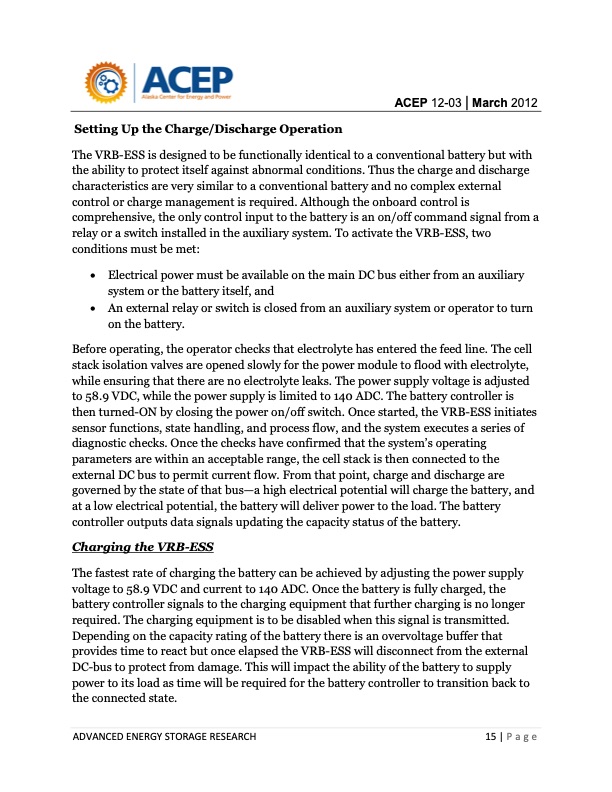
PDF Publication Title:
Text from PDF Page: 027
The VRB-ESS is designed to be functionally identical to a conventional battery but with the ability to protect itself against abnormal conditions. Thus the charge and discharge characteristics are very similar to a conventional battery and no complex external control or charge management is required. Although the onboard control is comprehensive, the only control input to the battery is an on/off command signal from a relay or a switch installed in the auxiliary system. To activate the VRB-ESS, two conditions must be met: • Electrical power must be available on the main DC bus either from an auxiliary system or the battery itself, and • An external relay or switch is closed from an auxiliary system or operator to turn on the battery. Before operating, the operator checks that electrolyte has entered the feed line. The cell stack isolation valves are opened slowly for the power module to flood with electrolyte, while ensuring that there are no electrolyte leaks. The power supply voltage is adjusted to 58.9 VDC, while the power supply is limited to 140 ADC. The battery controller is then turned-ON by closing the power on/off switch. Once started, the VRB-ESS initiates sensor functions, state handling, and process flow, and the system executes a series of diagnostic checks. Once the checks have confirmed that the system’s operating parameters are within an acceptable range, the cell stack is then connected to the external DC bus to permit current flow. From that point, charge and discharge are governed by the state of that bus—a high electrical potential will charge the battery, and at a low electrical potential, the battery will deliver power to the load. The battery controller outputs data signals updating the capacity status of the battery. Charging the VRB-ESS The fastest rate of charging the battery can be achieved by adjusting the power supply voltage to 58.9 VDC and current to 140 ADC. Once the battery is fully charged, the battery controller signals to the charging equipment that further charging is no longer required. The charging equipment is to be disabled when this signal is transmitted. Depending on the capacity rating of the battery there is an overvoltage buffer that provides time to react but once elapsed the VRB-ESS will disconnect from the external DC-bus to protect from damage. This will impact the ability of the battery to supply power to its load as time will be required for the battery controller to transition back to the connected state. ACEP 12-03 | March 2012 Setting Up the Charge/Discharge Operation ADVANCED ENERGY STORAGE RESEARCH 15 | P a g ePDF Image | Advanced Battery Storage Systems Testing at ACEP VRB ESS

PDF Search Title:
Advanced Battery Storage Systems Testing at ACEP VRB ESSOriginal File Name Searched:
ACEP-VRB-Testing-Report.pdfDIY PDF Search: Google It | Yahoo | Bing
Salgenx Redox Flow Battery Technology: Salt water flow battery technology with low cost and great energy density that can be used for power storage and thermal storage. Let us de-risk your production using our license. Our aqueous flow battery is less cost than Tesla Megapack and available faster. Redox flow battery. No membrane needed like with Vanadium, or Bromine. Salgenx flow battery
| CONTACT TEL: 608-238-6001 Email: greg@salgenx.com | RSS | AMP |